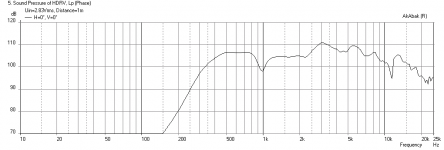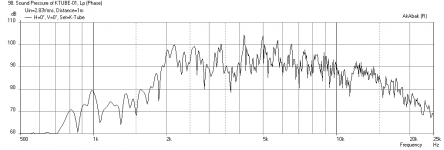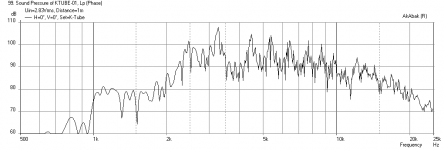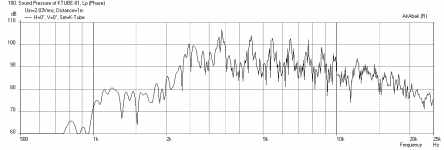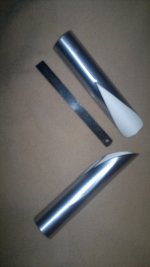K15 (if not bogged down by heavy woofer) imo has a very "agile" bass presentation and that 60->150 range is a sweet spot for a lot of music. K15 sounds realistic on plucked and bowed bass viola. Reflex and compromised horns can drone when trying to reproduce bowed bass.
a DBR can be an improvement over a single tuned reflex but a DBR is still a direct radiator.
K12 can exhibit an ~200Hz cavity peak and lacks some low bass to balance it out - can a higher aspect K12 control that peak so the response is neutral? Does the Karlsonator lose that punch in tradeoff for greater LF extension?
It would be nice to have some smaller Ks which have that long-throw bass shelf.
correct me if wrong, but it seems the Karlson does better with regards to the cone not unloading below cutoff than BVR
a DBR can be an improvement over a single tuned reflex but a DBR is still a direct radiator.
K12 can exhibit an ~200Hz cavity peak and lacks some low bass to balance it out - can a higher aspect K12 control that peak so the response is neutral? Does the Karlsonator lose that punch in tradeoff for greater LF extension?
It would be nice to have some smaller Ks which have that long-throw bass shelf.
correct me if wrong, but it seems the Karlson does better with regards to the cone not unloading below cutoff than BVR
I apologize if this question has been answered/discussed elsewhere. I did a quick google search and couldn't come up with much..
What effects (if any) do these Karlson designs have on a full-range driver's mid to high frequency output, more specifically, in regards to directivity and diffraction? What about the ability to project highs and vocals to further distances? Do they provide any help with beaming issues? And if so, to what degree?
What effects (if any) do these Karlson designs have on a full-range driver's mid to high frequency output, more specifically, in regards to directivity and diffraction? What about the ability to project highs and vocals to further distances? Do they provide any help with beaming issues? And if so, to what degree?
My Fe166e K-line was able to drop the sound stage of a recording into the listening room very well. I happened to like having the smaller cabinet rotated 90 degrees with the large open end of the tapers facing the side walls. Given how simple the foam core builds are you just might want to jump in and find out why those who have built Karlson's and variants are so impressed with them. Best regards Moray James.
The photo shows the tube tilted up. Did you run it like this?
I have them tilted up right now because I need to pad my tweeters down. Right now I'm running them without Lpads and the tweeters are too loud.
I look forward to your comments once you are able to adjust your K-tube level to match that of the Klam. Best regards Moray James.
I look forward to your comments once you are able to adjust your K-tube level to match that of the Klam. Best regards Moray James.
This weekend I'm going to move them to my bedroom and will get to play around more with room placement. They sound good in my office but due to limited space I've been limited on how I can set them up.
Directivity Measurements of Karlson Aperture
You might be interested in this measurement: http://www.diyaudio.com/forums/full-range/239386-karlsonator-3.html#post3569779
Basically, it shows that for vocals up to 3 kHz, the Karlson provides a 100 to 120 deg wide cone of sound that is lobe-free.
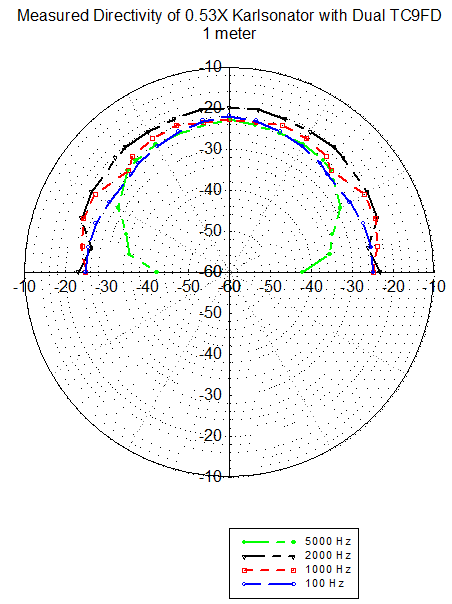
You might be interested in this measurement: http://www.diyaudio.com/forums/full-range/239386-karlsonator-3.html#post3569779
Basically, it shows that for vocals up to 3 kHz, the Karlson provides a 100 to 120 deg wide cone of sound that is lobe-free.

that's fantastic as vocals are a prime interest to many and ultimately the most expressive element - I would assume the dispersion effect on the Karlsonator 12 loaded with a 12" driver would be shifted downwards ???
here's a pic of two of my K12 - I'd not normally use a horn on top but it was handy to evaluate a new screw-on compression driver
here's a pic of two of my K12 - I'd not normally use a horn on top but it was handy to evaluate a new screw-on compression driver
An externally hosted image should be here but it was not working when we last tested it.
I apologize if this question has been answered/discussed elsewhere. I did a quick google search and couldn't come up with much..
What effects (if any) do these Karlson designs have on a full-range driver's mid to high frequency output, more specifically, in regards to directivity and diffraction? What about the ability to project highs and vocals to further distances? Do they provide any help with beaming issues? And if so, to what degree?
My sims and the measurements I have seen posted seem to indicate that the Karlson has output out to about 5 kHz for larger drivers. Above that a K tube tweeter or a coax horn, etc are needed. With a Karlsonator scaled down to utilize a small 3.5 inch fullrange, I think I am getting full range out to at least 15 kHz (limit of my of my hearing). The K aperture does seem to improve the directivity of frequencies up to 3 kHz which is where vocals are up to. I have some measurements of the directivity posted earlier in this thread http://www.diyaudio.com/forums/full-range/239386-karlsonator-3.html#post3569779
K-Tube Model
I am trying to model the K-tube tweeter in AkAbak. I am using a rectangular cross section rather than round and I have the CSA tapering to about 25% of the initial value over the length of the Karlson aperture which ranges from 3 to 5 inches long. The Karlson aperture is approximated with 14 segments. The width of the tube varies from 1.25 in to 1.0 in. The compression driver is a generic one that was provided as an example in AkAbak capable of producing about 105 dB in a 53 cm wide x 47 cm deep exponential radial horn. I am getting a rather ragged looking frequency response - not sure if I am doing this right but the efficiency is only in the 90 dB and falls off to about 80 dB at 20 kHz. Let me know if I am on the right track or this is all wrong looking.
Thanks,
X
This is the output of the CD with the radial horn as a baseline
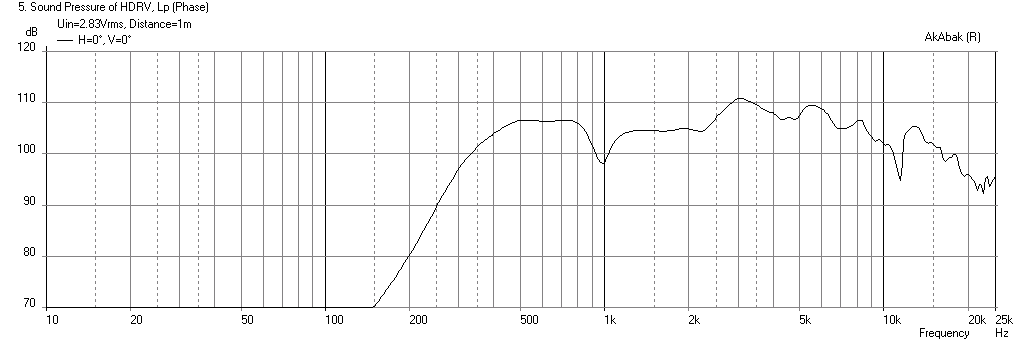
This is a 5 in long x 1.25 in square K-tube (2.5 kHz x-12 dB/oct Butterworth high pass filter used)
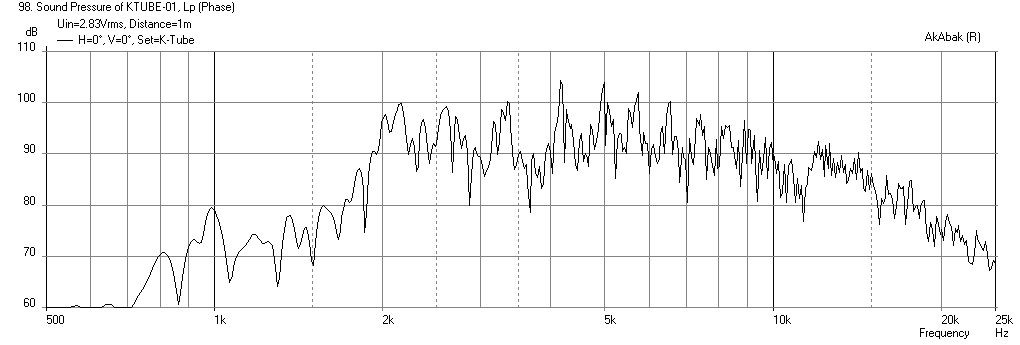
This is a 3 in long x 1.25 in square K-tube (2.5 kHz x-12 dB/oct Butterworth high pass filter used)
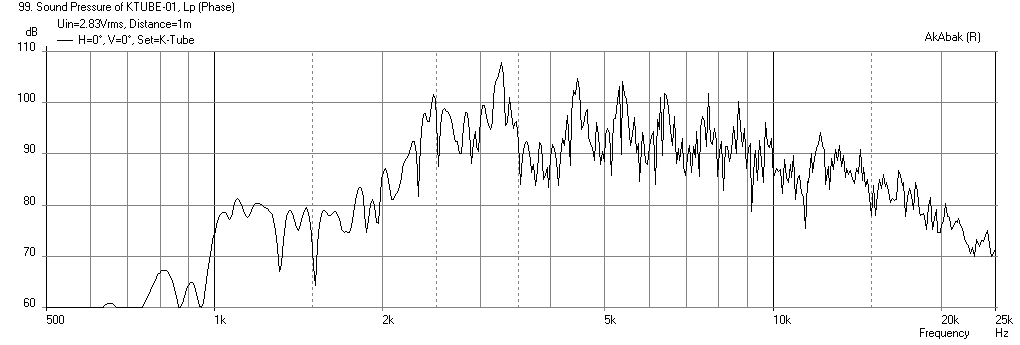
This is a 3 in long x 1.0 in square K-tube (2.5 kHz x-12 dB/oct Butterworth high pass filter used)
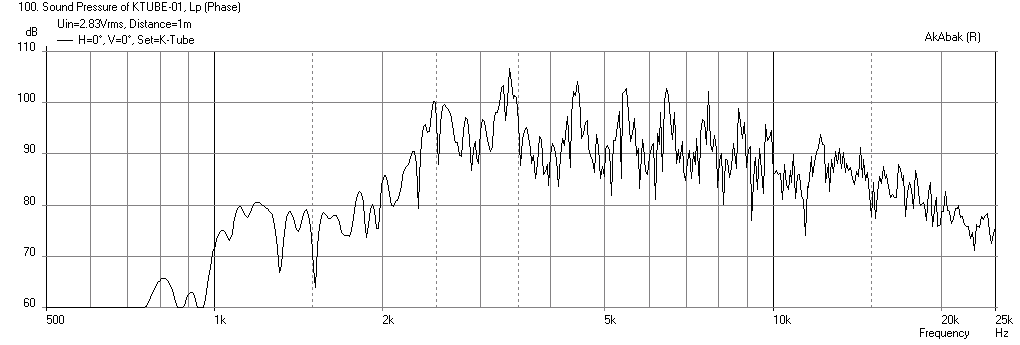
I am trying to model the K-tube tweeter in AkAbak. I am using a rectangular cross section rather than round and I have the CSA tapering to about 25% of the initial value over the length of the Karlson aperture which ranges from 3 to 5 inches long. The Karlson aperture is approximated with 14 segments. The width of the tube varies from 1.25 in to 1.0 in. The compression driver is a generic one that was provided as an example in AkAbak capable of producing about 105 dB in a 53 cm wide x 47 cm deep exponential radial horn. I am getting a rather ragged looking frequency response - not sure if I am doing this right but the efficiency is only in the 90 dB and falls off to about 80 dB at 20 kHz. Let me know if I am on the right track or this is all wrong looking.
Thanks,
X
This is the output of the CD with the radial horn as a baseline

This is a 5 in long x 1.25 in square K-tube (2.5 kHz x-12 dB/oct Butterworth high pass filter used)

This is a 3 in long x 1.25 in square K-tube (2.5 kHz x-12 dB/oct Butterworth high pass filter used)

This is a 3 in long x 1.0 in square K-tube (2.5 kHz x-12 dB/oct Butterworth high pass filter used)

Attachments
Last edited:
While it won't be as efficient as a horn, it'll be better than 90dB and falling. Can Akabak support a circular cross-section? I don't have absolute SPL measurements, but it was at least comparable to mini a Smith-horn and conical horn I fabricated. All measurements below using BMS 4550 and a 1.5kHz PLLXO.
Blue trace = Smith
Red trace = Woodhorn
Green trace = K-Tube
IG
Blue trace = Smith
Red trace = Woodhorn
Green trace = K-Tube
An externally hosted image should be here but it was not working when we last tested it.
An externally hosted image should be here but it was not working when we last tested it.
IG
that's fantastic as vocals are a prime interest to many and ultimately the most expressive element - I would assume the dispersion effect on the Karlsonator 12 loaded with a 12" driver would be shifted downwards ???
here's a pic of two of my K12 - I'd not normally use a horn on top but it was handy to evaluate a new screw-on compression driver
An externally hosted image should be here but it was not working when we last tested it.
Freddie, what is this baffle in the center of the picture ? Looks like a JBL or Sansui of some kind.
The Karlson aperture is approximated with 14 segments.
And looks about that many lumps in the response. Coincidence?
Those lumps or peaks are actually there with a straight tube with no Karlson slot. They are the resonant modes that the slot is supposed to suppress or reduce. It may be that at these small wavelengths, the size of the segments needs to be smaller to work in smoothing out the response.
Has anyone tried a ducted port (maybe mailing tube) as a vent? I had considered it as a means to match a driver to the enclosure but with no lab it would all be empirical and subjective. I guess John Tucker's PVC elbows come closest to the concept but don't allow for experimentation.
that probably could work for some speakers - if the ducts are real close to a rear lowpass shelf, then they may not tune quite as predicted. It would be useful to have a test coupler with removable port panel and gather response & input impedance curves. Other things such a making the rear shape and port like Acoustic Control's 115BK might be useful for some situations. I've wondered how a 115BK scaled for 18" would do response-wise. Greg B's Karlsonator series tend to be larger and tune lower than Karlson's originals. Carl N. swears by use of curved reflectors (especially Fig.6) per Karlson patent 3540544 but use of those alone does not guarantee response without dips. A front stub above the aperture be used to change response and smooth things. I think a test-box with a lot of removable features would help sort out some stuff. The K-tube should always be considered before using a horn or waveguide in two way K's when the woofer can comfortably reach 1K2Hz. or higher. X15 used the tube inside the front coupler and it worked very well.'s
below is a test box by Carl loaded with an 8 inch speaker and a laminated veneer K-tube - by going to a higher aspect, I think in general the front tuning is somewhat lower and there's less energy at the cavity peak region. The original Ks have more "hit".
there is a fully curved reflector in this cabinet and I think the vent occurs "above" that reflector.
the chamber would have a profile like AmadeusMozart made in a 6.5" version - this is quite a bit different
than the Karlsonator approach
below is a test box by Carl loaded with an 8 inch speaker and a laminated veneer K-tube - by going to a higher aspect, I think in general the front tuning is somewhat lower and there's less energy at the cavity peak region. The original Ks have more "hit".
there is a fully curved reflector in this cabinet and I think the vent occurs "above" that reflector.
An externally hosted image should be here but it was not working when we last tested it.
the chamber would have a profile like AmadeusMozart made in a 6.5" version - this is quite a bit different
than the Karlsonator approach
An externally hosted image should be here but it was not working when we last tested it.
Last edited:
I find these 'K' speakers fascinating to say the least, so.......
I thought I'd get in on things and try a 'K-Tube', there's no math behind these, just wrapped 'stainless-alike' vinyl (used for sign making etc) round a 34mm form, a bit of artistic license with a sharpie and a few deft cuts with some scissors produced these.
Too late to play music at reasonable levels, so no impressions as yet.
Tweeters are some 1" fabric soft dome Wharfdale's I salvaged and run on top of my EmKens with a 2.2uF cap for cross-over.
I thought I'd get in on things and try a 'K-Tube', there's no math behind these, just wrapped 'stainless-alike' vinyl (used for sign making etc) round a 34mm form, a bit of artistic license with a sharpie and a few deft cuts with some scissors produced these.
Too late to play music at reasonable levels, so no impressions as yet.
Tweeters are some 1" fabric soft dome Wharfdale's I salvaged and run on top of my EmKens with a 2.2uF cap for cross-over.
Attachments
hi sippy - those are way kool looking - you could also try a tube a bit smaller but large enough to clear the dome - make it about 13.5cm long with nearly a full length slot - kinda like the white pvc on the right:
a really quick tube can be fashioned from rolled up paper with an eyeballed scissor cut
if the tube's slot is facing "down" , then the tube might be elevated maybe 12 to 30 degrees
if the tube's slot is facing "up", then the tube would be tilted down
it may or may not need EQ - most compression drivers work perfect on a tube the
size below without any contour - I'm not sure how a dome tweeter would do with this
particular slot - yiou might have to play it by ear with a few tries.

Pioneer BOFU with helper tube
a really quick tube can be fashioned from rolled up paper with an eyeballed scissor cut
if the tube's slot is facing "down" , then the tube might be elevated maybe 12 to 30 degrees
if the tube's slot is facing "up", then the tube would be tilted down
it may or may not need EQ - most compression drivers work perfect on a tube the
size below without any contour - I'm not sure how a dome tweeter would do with this
particular slot - yiou might have to play it by ear with a few tries.
An externally hosted image should be here but it was not working when we last tested it.

Pioneer BOFU with helper tube
An externally hosted image should be here but it was not working when we last tested it.
Last edited:
Hmmm, the pic of the two tubes next to each other, if roughly 13cm, have slightly longer 'slots' than mine.
I taped and bits of stringed them in place over the dome - horizontal and facing inwards.
I listened to a bit of 'Clair Jones - The Girl With The Golden Harp'.
I'll say this - I can now hear Where Mrs Jones fingers touch the strings and hear the orientation of the instrument!
I do run some EQ and I left it alone.... bare tweeter can be a bit 'spitty' round the x-over to the 12lta, this seems to be lessened with the tubes in place
Maybe its because they are in effect a laminate
I'll see how they go when I can wind the loud knob up the scale and play with orientation for a few days.
Just watched a Peregrine Falcon bag a something on the cliff face opposite my flat, cant see what it is with the aid of my farnoculars - must be a rat. They nest in the next cove round and I can spend hours watching them dynamic soaring when theres a big blow off the Atlantic.
I taped and bits of stringed them in place over the dome - horizontal and facing inwards.
I listened to a bit of 'Clair Jones - The Girl With The Golden Harp'.
I'll say this - I can now hear Where Mrs Jones fingers touch the strings and hear the orientation of the instrument!
I do run some EQ and I left it alone.... bare tweeter can be a bit 'spitty' round the x-over to the 12lta, this seems to be lessened with the tubes in place

Maybe its because they are in effect a laminate
I'll see how they go when I can wind the loud knob up the scale and play with orientation for a few days.
Just watched a Peregrine Falcon bag a something on the cliff face opposite my flat, cant see what it is with the aid of my farnoculars - must be a rat. They nest in the next cove round and I can spend hours watching them dynamic soaring when theres a big blow off the Atlantic.
- Home
- Loudspeakers
- Full Range
- Karlson
